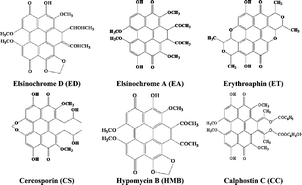Photophysics, photochemistry, and reactivity: Molecular aspects of perylenequinone reactions
Abstract
Density functional theory (DFT) and time-dependent density functional theory (TD-DFT) were used to elucidate the photochemistry and photophysics of eight different perylenequinones (PQ). The objective of this work has been to quantitatively investigate the photodynamic therapeutic potential of this family of compounds and give an overview of their photoreactivity. The effects of solvation were evaluated through single-point calculations using the integral equation formalism of the polarised continuum model. It is concluded that the eight studied perylenequinones can generate singlet oxygen (in aqueous solution) and superoxide


 Please wait while we load your content...
Please wait while we load your content...